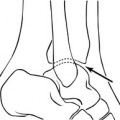Chapter 10 Venous system
Peripheral Venography
LOWER LIMB
Patient preparation
The leg should be elevated overnight to lessen oedema if leg swelling is severe.
Technique
2. A tourniquet is applied tightly just above the ankle to occlude the superficial venous system. This may also occlude the anterior tibial veins, and so their absence should not automatically be interpreted as due to venous thrombosis.
3. A 19G butterfly needle (smaller if necessary) is inserted into a vein on the dorsum of the foot. If the needle is too near the ankle, the contrast medium may bypass the deep veins and so give the impression of deep venous occlusion.
5. A further 20 ml bolus is injected quickly whilst the patient performs a Valsalva manoeuvre to delay the transit of contrast medium into the upper thigh and pelvic veins. The patient is tilted quickly into a slightly head down position and the Valsalva manoeuvre is relaxed. Alternatively, if the patient is unable to comply, direct manual pressure over the femoral vein whilst the table is being tilted into the head-down position will achieve the same effect. Films are taken 2–3 s after releasing pressure.
CENTRAL VENOGRAPHY
SUPERIOR VENA CAVOGRAPHY
Equipment
Rapid serial radiography unit, or preferably a C-arm with digital subtraction angiography.
Technique
3. Hand injections of contrast medium 30 ml per side, are made simultaneously, as rapidly as possible by two operators. The injection is recorded by rapid serial radiography (see ‘Films’ below). The film sequence is commenced after about two-thirds of the contrast medium has been injected.







